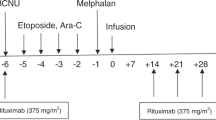Abstract
We previously reported feasibility and efficacy of a monocentric pilot study of intensive sequential chemotherapy (ISC) in poor-risk aggressive non-Hodgkin’s lymphoma (NHL) in patients <60 years. to validate these results on a large cohort of patients, we designed a new and oligocentric study. after a cop (cyclophosphamide (cy), vincristine (vcr), prednisone (pred) debulking, patients received four courses of high-dose chop (cy, doxorubicin (doxo), ver, pred), with the addition of etoposide and cisplatin during the two last courses. g-csf was delivered after each cycle, and peripheral blood stem cells (pbsc) were used to support the two last cycles. total duration of chemotherapy was 13 weeks, with a planned dose-intensity (di) of 1420 mg/m2/week and 23 mg/m2/week for Cy and Doxo, respectively. Radiotherapy (involved fields) was then delivered for patients with node size ≥ 5 cm at diagnosis. Forty-two patients were enrolled in this study; 36 completed the treatment and received 75% or more of the planned DI for both Cy and Doxo. Median duration of grade 4 neutropenia was 14 days (range, 2 to 28) for the regimen as a whole, and median duration of rehospitalization for febrile neutropenia was 18 days (range, 4 to 41). Overall response rate was 83%, with 29 patients (69%) in complete response (CR). Six patients failed to respond and one died of toxicity. With a median follow-up of 22.5 months (range, 10 to 42), the 3-year event-free survival (EFS) is 55% (95% CI, 39–71), while disease-free survival (DFS) is 79% (95% CI, 63–95). Ambulatory ISC is accessible and feasible in an oligocentric study. PBSC allow repeated delivery of high-dose chemotherapy cycles, and result in encouraging CR, EFS, and DFS rates for poor-risk aggressive NHL’s patients.
Similar content being viewed by others
Author information
Authors and Affiliations
Rights and permissions
About this article
Cite this article
Bouabdallah, R., Stoppa, AM., Rossi, JF. et al. Intensive sequential chemotherapy (ISC 95) with growth factors and blood stem cell support in high–intermediate and high-risk (IPI 2 and IPI 3) aggressive non-Hodgkin’s lymphoma: an oligocentric report on 42 patients. Leukemia 13, 950–956 (1999). https://doi.org/10.1038/sj.leu.2401444
Received:
Accepted:
Published:
Issue Date:
DOI: https://doi.org/10.1038/sj.leu.2401444
- Springer Nature Limited




